ASD students’ needs - Module 2
| Site: | IPA2 e-Learning Platform |
| Course: | Prevention of absenteeism and school failure in students with ASD: Improving the transition from primary to secondary school |
| Book: | ASD students’ needs - Module 2 |
| Printed by: | Guest user |
| Date: | Friday, 22 November 2024, 2:13 AM |
1. HOW TO IDENTIFY A STUDENT WITH ASD IN CLASSROOM?
Students with ASD present a series of characteristics throughout their school life which causes a great impact on the environment, they present many alterations in the main areas of development: communication and language, social interaction, behaviour or other manifestations such as sensory or difficulties at the motor level.
Figure 1. ASD characteristics and manifestations in the classroom. Page 11-13. Autism Federation Castilla y León, 2018. Guide for teachers and educators of students with autism.
2. CLASSROOM. THE REASON FOR THE ORGANIZATION
It is very necessary that the classroom is structured and has marked and orderly environments since it will be easier to prevent future incidents. Therefore, the environment must be as computerized as possible avoiding changes and without too much information that can distract, therefore the more organized the classroom is, the easier it will be to predict what will happen in it.
Thanks to this structure and predictability of the classroom, students will be able to: know the basic behaviour guidelines; be assured of what is expected of him or her and; know that the teacher directs situations by being predictable.
2.1. Classroom structuring
To design the structured environment, we must have the TEACCH method (Treatment and Education of Autistic and Related Communication Handicapped Children), whose purpose is to achieve the maximum degree of autonomy of the students. With this method, what is intended is: to physically structure the classroom, organize work systems, work with the use of agendas and provide as much visual information as possible.
The objectives are:
- Help them understand situations and expectations.
- Help them to be calm.
- Help them learn better using the visual channel.
- Endow with independence.
- Reduce behaviour problems
2.1.1 Physical structure of the classroom
For the physical structuring of the classroom, the needs or learning styles of each student with ASD must be observed. Depending on where the furniture is located, it can affect the ability of students to function in the environment and act independently. An adequate organization is clear and accessible for students with ASD if the classroom layout is correct since the presence of distractions can be reduced.
To organize the classroom we must take into account a series of premises: the classroom must be divided into specific areas or corners: reading corner, individual work corner, computer corner, etc.; the corners should be visually highlighted, generating
spaces with clear limits; the classroom has to be adapted to the needs and cognitive and emotional characteristics of the students and; It is important to use adapted materials that indicate what to do, when an activity is finished or where the material
is kept.
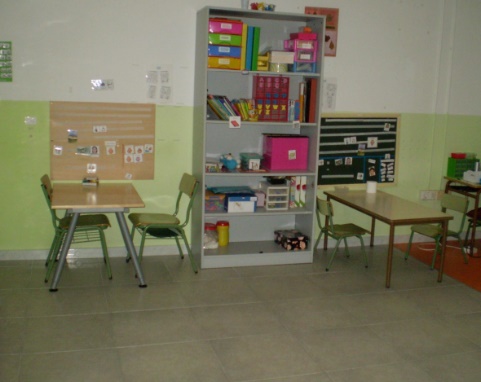 |
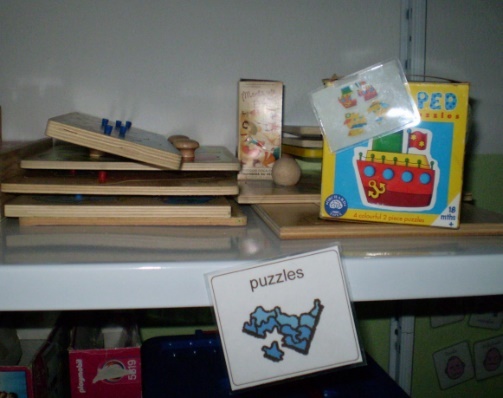 |
|---|---|
| Organized environment structure | Visual information |
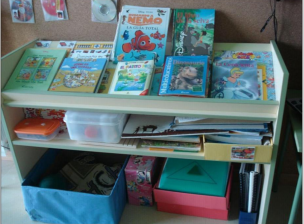 |
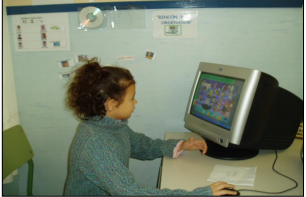 |
| Reading corner | Computer corner |
In relation to the location of the student to the teacher, it must be decided based on the student's needs:
- Face to face. It is the strictest situation from a social point of view, constantly requiring attention and responding to another person.
- Next to each other. It facilitates imitation, the attention is not only focused on the teacher, but on the materials and instructions.
- Behind. Much more emphasis is placed on independence and focus on activities.
2.1.2 Agendas
Daily agendas offer students a lot of clarity and predictability in their day-to-day life since they know what they have to do at all times. Apart from them, they have the opportunity to move around the classrooms and centres in a more autonomous way.
They offer them visual information about: where they are going to be, what activities they are going to do and in what order.
There are many types of agendas:
- Transition object
- Sequence of objects
- Unique photo / drawing
- Photo sequence for part of the day
- Sequence of drawings
- Written list
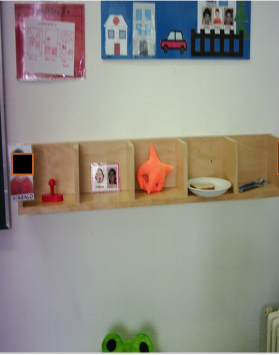
 |
 | |
|---|---|---|
| 1 | 2 | 3 |
 |
 |  |
| 4 | 5 | 6 |
2.1.3 Work systems
Work systems help them organize each of the activities that they have to carry out throughout the day and, they are very important to work without the constant supervision of an adult. The information that must be given to students when carrying out a work is:
- The work to be done.
- Certain organized ways to carry out the task.
- The number of tasks or activities and when they have to be completed.
- Self-evaluation by the student so that he is aware of when he is progressing.
- Self-knowledge of the end of the activity.
- Prevent what will happen at the end of the activity.
The purpose of work systems is to organize activities and provide meaningful and organized ways to perform specific activities. We find three types:
- From left to right, with “finished” container
- Pairing (colours, shapes, letters, etc.)
- Writings.
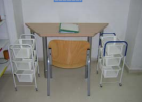 |
 |
 |
|---|---|---|
| 1 | 2 | 3 |
2.1.4 Visual information
Each task that they carry out has to be clearly structured and must be very visual to increase understanding. There are three components to consider:
- Visual clarity. This clarity can be achieved through:
- Specifying the components of a task
- Highlighting the relevant aspects of the tasks through: labels, highlighters, etc.
- Visual organization, through:
- The distribution and stability of the materials used to perform the tasks.
- Divide tasks into simpler parts.
- Visual instructions. Visual aids to understand what to do.
2.2. How inform about the homework?
When reporting homework, it is very convenient to use guidelines to avoid possible anxiety for students and that they can get to work more safely.
For this reason, to report the tasks the teacher can write the assignments with the indications of the same in a specific place for them and at the same time every day and, the same for the collection, a previously indicated place can be established in the classroom to drop them off or arrange for them to be picked up at a certain time of the day.
Once the student has collected the instructions for the task, if there are additional files to those in the book, it is very important that they are structured:
- A marked beginning and end must be given.
- Limit the options and state them clearly.
- In each task, the language must be clear, precise and concrete.
- When preparing the tasks, we must identify the strengths of the students or their interests so that the tasks are more motivating.
- It is important to be able to accompany the tasks with graphic material.
2.3. Adapted exams
When students with ASD have exams, it is very likely that they are anxious and do not know very well how to act, therefore, it is very important that we anticipate precisely what type of evaluation is going to be carried out as well as notify in advance of it ; Besides; in exams that are longer, it is convenient that they be divided and that they take as long as necessary; If we see that the written evaluation costs too much, we must consider the option of developing oral exams; and the corrections of the same must be shared so that the student understands the failures.
In relation to their structuring, it is relevant that in all subjects it is similar and that objective tests are carried out such as: multiple choice (true / false, choose options, etc.), underline or surround options, join with arrows or question answer. In addition, it must also be clearly indicated what each question counts and the approximate time of completion.
Finally, when taking the exam, it is convenient for students to have a sheet with a list of steps to be carried out in the exam, that is, a sheet in which it is clearly explained that the exam is section by section.
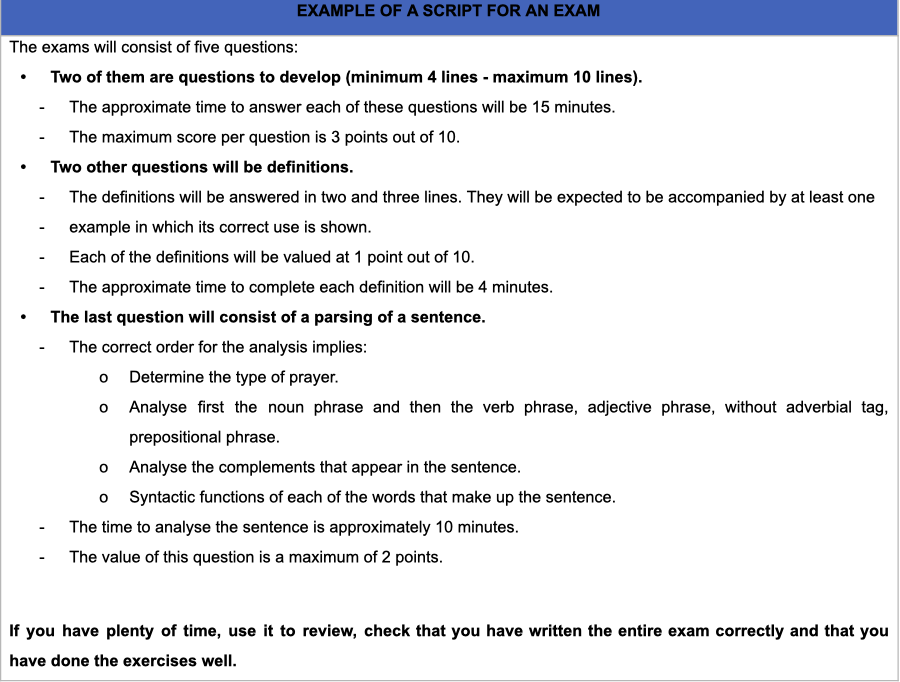
Figure 2. Script adapted exams. Page 42. Autism Federation Castilla y León, 2018. Guide for teachers and educators of students with autism.
2.4. Team work
In relation to group work, it is very likely that students with ASD feel uncomfortable since they do not feel comfortable with the structure of the work. The problems they may have are related to: the lack of explicit rules for group work; the little structuring; the lack of social communication; the amount of stimuli to which they may be subjected; carrying out activities that require a lot of creativity; activities that require a lot of speed or; the little presence of the interests of the students.
Therefore, for group work to be done in a more bearable way, it is convenient to carry out a series of guidelines such as:
- Carry out the groupings according to the students most related to the student with ASD.
- Provide explicit information.
- Provide written job requirements.
- Extend presentation times, giving the option of preparing the work in different formats, etc.
- Use temporal and spatial structuring strategies respecting the routines to which they are accustomed in students with ASD.
- Offer scripts that facilitate the elaboration of creative activities.
- Closely supervise the group.
- Self-evaluate the activity together with the student with ASD so that they offer information about what they liked, what they least liked or what they found the most difficult.
2.5. Problems with a specific subject
Probably students with ASD may have problems with a specific subject due to:
- Difficulty in planning and solving problems, problems in understanding and difficulty in understanding abstract concepts.
- Focus on insignificant details, not capturing the main ideas of the tasks.
- Appear distracted and have more specific attention time on tasks not chosen (Merino M., García R. 2011 p. 46)
Therefore, to avoid problems with a specific subject, it is convenient that all the agents of the centre are coordinated and follow a series of common guidelines:
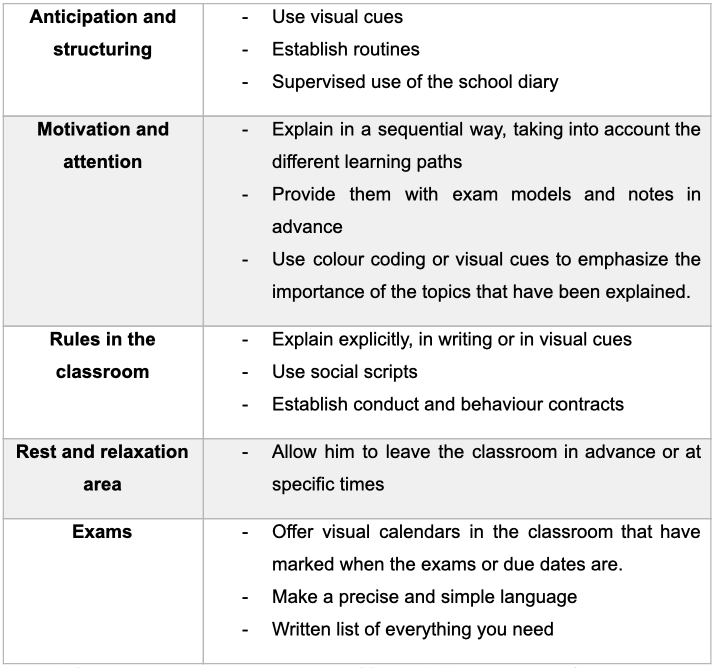
Figure 3. Supports in the subjects. Page 47. Merino M., Gómez R. 2011. Intervention guide for students with autism
2.6. Talents and centres of interest in the classroom
To work on the centres of interest in the classroom of students with autism, mention must be made of Howard Garner's theory of multiple intelligences. Gardner sees intelligence as the grouping of different specific abilities and defends intelligence as a skill. Thanks to this model we can adapt to the intelligence model of each student with ASD, only teaching the same concepts but in a different way. He identifies eight types of intelligences:
- Verbal - linguistics
- Logical - mathematical
- Corporal - kinesthetic
- Visual - spatial
- Intrapersonal
- Interpersonal
- Musical
- Naturalist
2.7. Activities that require public presentation
Students with ASD have problems when they have to express things that require presentations in public due to their communication problems and problems of relationships with the rest of their classmates; Therefore, it is important to work on various aspects such as: memory, problem solving, language, motivation and sequences.
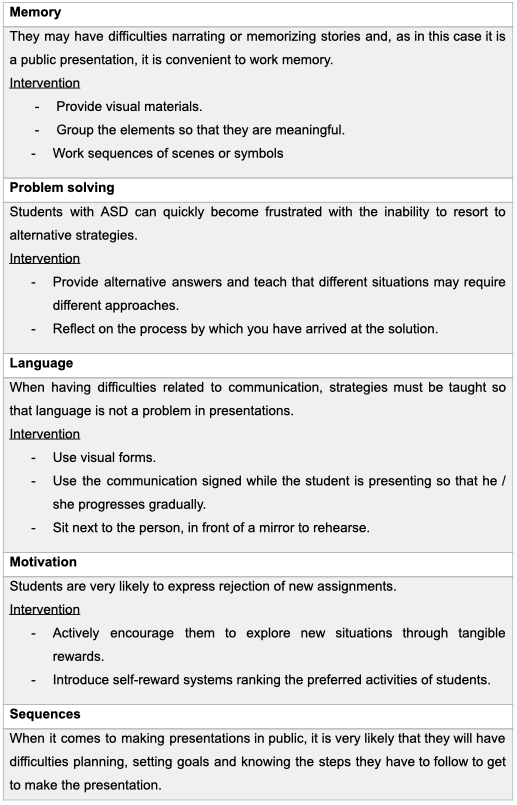
Figure 4. Needs related to the learning of ASD students. Adapted from Jordan and Powel (1992). Page 159-160. Cuesta J.L and Cols, 2016. Autism spectrum disorder: educational intervention and training throughout life. Psychology, Society & Education, Vol. 8 (2)
2.8. Competitive and cooperatives activities in physical education
It is very likely that students with ASD do not feel comfortable in the physical education subject due to their high degree of relationship with the rest of their classmates, this is because they can encounter a series of barriers such as:
- The spaces where the subject is developed are spaces with a lot of noise.
- They may have problems in the ability of visuospatial perception and visual-motor coordination.
- The practice of sports that requires a high level of social relationship, which the majority of students with ASD reject.
- Autonomy skills.
Therefore, to solve these barriers, it is very important that they be given a series of facilitators such as:
- Use of visual aids to anticipate the activities that will be carried out in the classroom.
- Reinforce the visual presentation with explanations of the steps to follow.
- Form inclusive and equitable groups.
- Provide students with a relaxation corner where they can go if they feel overwhelmed.
- Evaluate them based on their evolution, considering effort, participation, without taking as a reference the performance of their group-class.
- Allow more time between physical education class and the next.
3. COMMUNICATION
One of the great barriers for students with ASD is the lack of communication with the rest since it is difficult for them to initiate social communication; present impediments to establish reciprocal conversations; sometimes they don't understand what is being said to them or; in some cases, they do not have eye contact and their attention is poor. Therefore, it is very important to have strategies to communicate with students with ASD.
Apart from communicating with students as well, it is very important to maintain fluid communication with parents in order to observe the changes, needs and evolutions of their children.
3.1. Basic adaptations in communication with students
In most cases, students with ASD may have problems related to comprehension such as: not understanding the messages that are transmitted orally; They may have difficulty integrating words into the sentence or context, making it difficult for them to extract the full meaning, to understand the non-literal meaning of oral language, and to understand non-verbal communication.
To help students understand what is being said correctly, it is very important to have a series of strategies:
- Speak with clear style, avoiding ambiguities.
- Avoid sarcasm, irony or double meanings or else explain them well to avoid misunderstandings.
- Make some concepts explicit, especially those related to social relationships.
- You have to give them time to process the information.
- Provide context for words to make it easier for them to understand.
- Help us with images to communicate.
3.2. Coordination with parents
A very important agent in the school life of students with ASD is the collaboration of the family with the school, therefore, a good model for communication between the center-family is the Family-Centred Model, which aims to serve their peculiarities, starting from the strengths they have and accepting the choices.
In addition, this model promotes continuous collaboration with family and professionals so that everyone works together in decisions regarding the student with ASD. For this reason, it is necessary that they receive constant information and hold regular meetings with professionals.
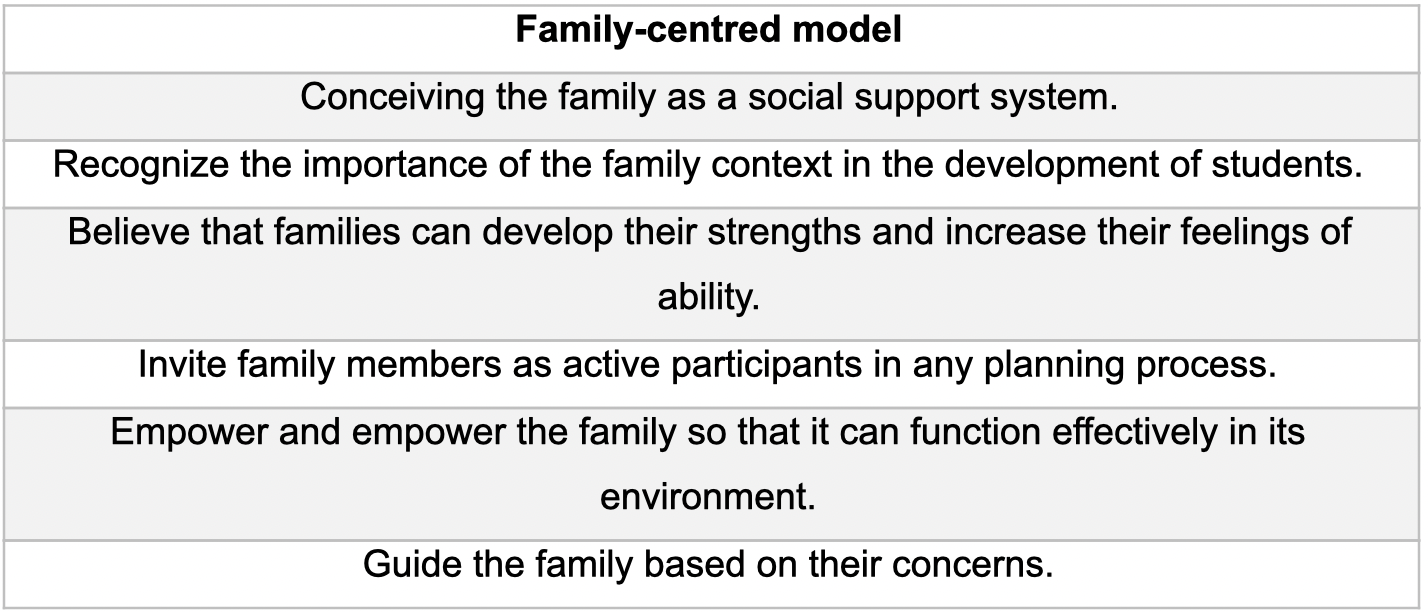
Figure 5. Family centred model. Page 84. Romero A and Cols, 2019. Students with ASD. Guidelines for planning the educational response. Educational proposals to intervene in infant, primary and secondary school.
Therefore, following this model, parents have to be involved in school decisions and help at home with the dynamics that follow in the classroom, for example: helping students to prepare the weekly calendar with images of the activities they are going to do. perform throughout the week; visually organize exams and assignments to be turned in or; notify in advance of the extracurricular activities that are going to be carried out.
3.3. How to manage the social information with the family?
To manage the social information that arises in the classroom, it is very important that there is a climate of trust and that there is a continuous climate of dialogue and communication. Therefore, to handle all the social information in the classroom it is very important that we be guided by a series of dimensions.
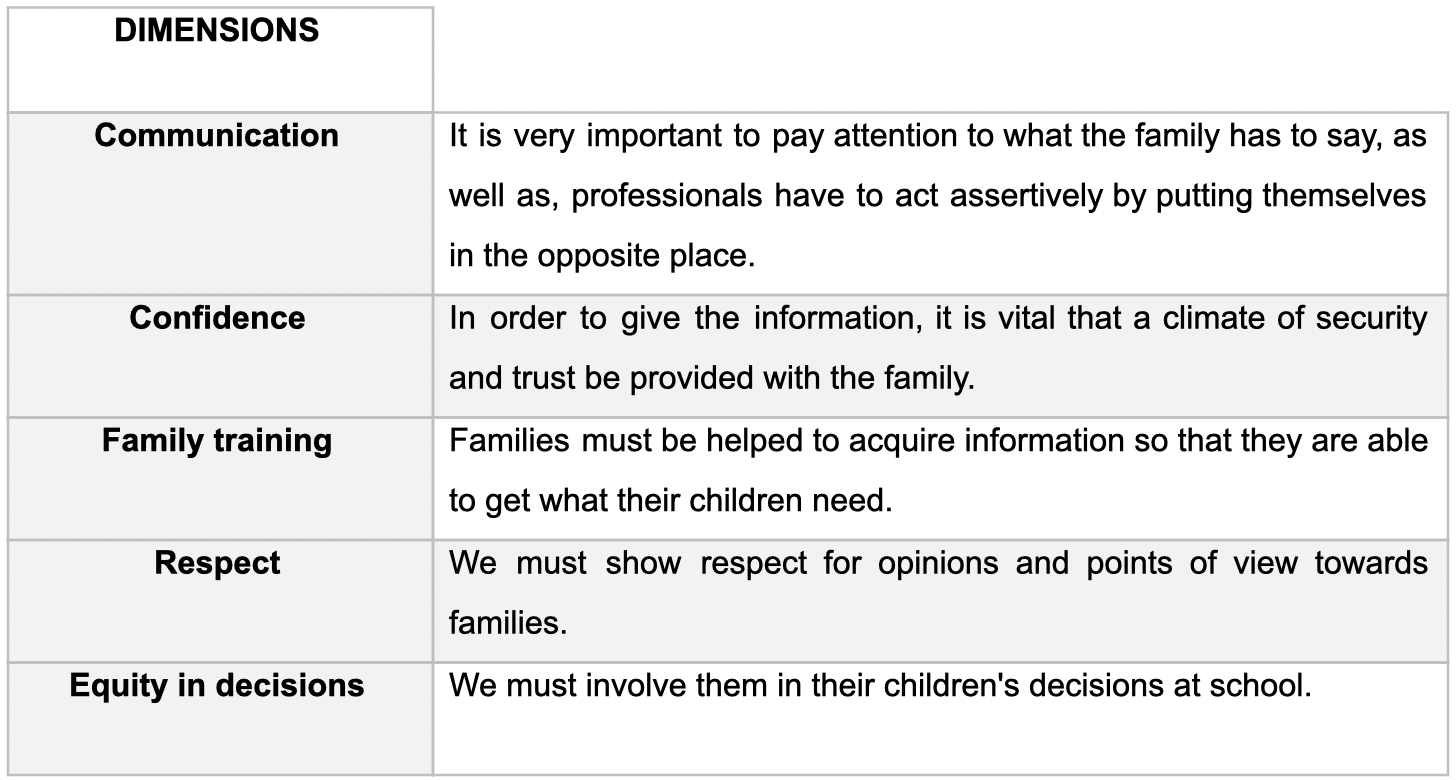
Figure 6. Communication dimensión. Pág 85. Romero A and Cols, 2019. Students with ASD. Guidelines for planning the educational response. Educational proposals to intervene in infant, primary and secondary school.
4. CHANGES AND MOMENTS WITHOUT STRUCTURE
Students with ASD have to have everything that is done in the day-to-day totally clear and integrated even when they have not foreseen any change since any change that is made, even very small, can increase their anxiety.
4.1. Notify students of changes
To notify the students of the changes, it is necessary to prepare it in advance, for this it is very convenient that we use Social Stories (prepared by Carol Gray in 2000). These are short narratives, as a script accompanied by images that explain the information of a specific context, inform about why it happens, which people are going to be related and how the protagonist should act.
Through these stories the main objective is to provide students with ASD through descriptive phrases so that they know how to direct their actions. For example, in the following picture we can see how they tell the student with ASD how to act when they get angry

Figure 7. Example of social history
Apart from the social stories, it is also advisable at times to provide visual schemes that incorporate the activities of the students, this helps us to introduce specific changes at certain times. In the following image you can see an example of how a routine change schedule has been developed.
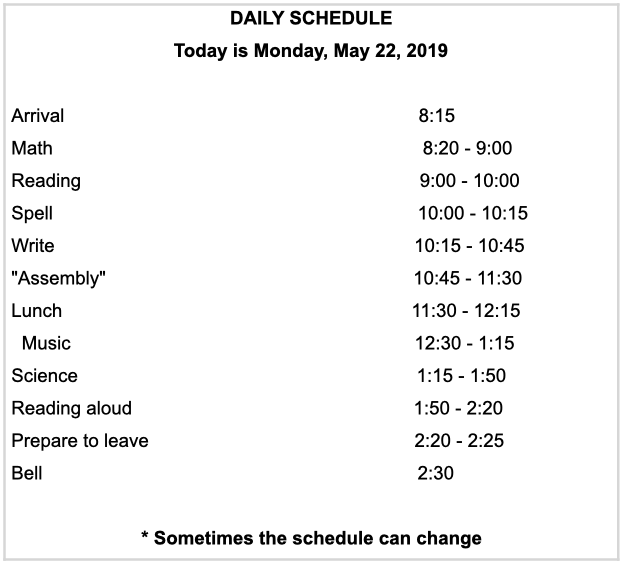
Figure 8. Example of schedule. Page 13. Smith B and Cols (s.f.). Simple strategies that work. Helpful tips for all student educators include Asperger's Syndrome, High-Functioning Autism, and Related Disabilities.
4.2. How to structure moments without structure?
The moments without structure can be tremendously difficult that can generate conflicts for that reason, they are spaces in which sensory disturbances, sensory difficulties, the great amount of stimuli or little socialization can make them feel very lost. Like, they are moments in which repetitive and stereotyped behaviours increase to try to reduce the stress that these types of situations generate.
In relation to these moments, on the one hand, we find recesses and, on the other, the exits and entrances to the school and the transits between classes. Starting with recesses, it is very likely that students with ASD feel uncomfortable when they have to go out to the playground because: it is a poorly structured situation; there is a lot of weight in verbal exchanges between students; they don't have many relational skills and; They have very restricted and focused interests for this reason, to avoid the anxiety that may arise at this time it is very important to develop a series of strategies so that they spend that time as comfortable as possible.
Strategies to facilitate going out to recess
- Develop leisure alternatives such as guided games.
- Establish the rotating figure of a game mediator between the peer group and the students with ASD, so that they act as supports to develop the activities.
- Organize games and review the rules with all the students.
- Develop routines through scripts to promote communication and interaction with classmates at recess.
- What is your favourite food?
- What is your favourite television series?
- What have you done this weekend?
- How did the exam go?
- Teach explicitly to respond to unwanted jokes and social behaviour.
Going to the exits and exits together with the transits between class and class, it is very likely that the student body will have problems related to frequent class changes and the speed with which they are carried out, as well as: crowds when traveling; the accidental frequency of physical contact; sensory characteristics; motor coordination; spatial orientation and; the scant interpretation of the behaviours of others in case they are accidental or intentional. To try to make this happen we must follow a series of strategies.
Strategies for entries, exits and transits between class and class
- Allow the student to leave class a few minutes before or after the rest of his classmates.
- Promote tutoring activities among classmates using rotation.
- Create signs and make explicit the rules to favour movement.
- Adapt the acoustic signals to the characteristics of the student.
- Teach to interpret explicitly to interpret the behaviours of their classmates.
5. SENSORY STIMULES AND BEHAVIORAL PROBLEMS
Students with ASD have sensory needs, this is because their sensory system is impaired because "The nervous system is not able to properly interpret and organize the information captured by the various sensory organs of the body." (Bellefeuille, 2006, p.201). Apart from sensory problems, they can also have behaviour problems due to socio-communicative alterations, stereotyped behaviours, restricted interests and sensory alterations.
5.1. Sensory stimulation
Students with ASD may have sensory processing deficits, which, this can make them hypersensitive, that is, they have an exaggerated response to the demand of the environment or they are hyposensitive, which means that they lack reaction to the stimuli of the environment. environment. For example, the noise from a concert is likely to cause some children considerable discomfort while others are fascinated by the bright lights that routinely disturb the people around them.
To work on sensory integration dysfunction in the classroom, we must work with the sensory systems that we have: visual, auditory, olfactory, gustatory, tactile, proprioceptive (system that shows us the position of our body) and vestibular (related to movement, gravity and balance). In the following table are some strategies of how we can work these systems.
Figure 9. Sensory stimulation. Isep Clinic, 2016. Recovered from: https://isepclinic.es/blog/estimulacion-sensorial-tea/
5.2. Behavioural problems
Students with ASD may have difficulty understanding or misinterpreting the actions of their peers, therefore, they may have many behaviour problems. The lack of empathy and understanding of the emotional repercussions that their behaviours can cause on their peers can cause them to have inappropriate or even aggressive behaviours.
All this can generate uninhibited behaviours since in students with ASD cognitive empathy is normally altered "Ability to understand the thoughts that lead other people to certain emotions" (Hervás A., Rueda I., 2018) and more preserved emotional empathy, which is "The ability to emotionally tune into the emotions of other people" (Hervás A., Rueda I., 2018)
These behavioural alterations usually cause difficulties in cognitive flexibility, when organizing, planning, anticipating situations or responding in an organized and planned way to an unexpected situation.
Therefore, to reduce these behaviour problems we can follow some guidelines to change the desired behaviour:
- Environmental adaptations. We must remove the stimuli that cause hyper stimulation, create motivating activities and a space where students with ASD can relax.
- Change your emotional state. Carry out activities that change your emotional state favouring positive self-regulation.
- Use structure, routines and visual aids. The structure helps them to understand the environment, the routines to anticipate sequences and the images can be used as reminders or transitions.
- Use positive proactive instructions. If they are blocked, use activities that are pleasant and that are of interest to them and then try again.
- Use distraction and surprise situations to get them out of unwanted behaviours.
- Consequence-based interventions. Ignore harmless behaviour and redirect it to achieve the desired behaviour while removing any consequences that reinforce the behaviour.
6. REFERENCES
Autism Spain (2018). Communication with TEA students. Recovered from: http://www.autismo.org.es/actualidad/articulo/para-las-personas-con-tea-el-lenguaje-no-es-siempre-la-mejor-forma de#:~:text=Las%20personas%20con%20Trastorno%20del,y%20pueden%20tener%20muchas%20interpretaciones.
Autism Federation Castilla y León (2018). Guide for teachers and educators of students with autism. https://autismocastillayleon.com/wp-content/uploads/2016/06/guia_para_profesores_y_educadores_de_alumnos_con_autismo4.pdf
Beaudry I (2006). A sensory processing disorder is frequently the cause of learning, behavior, and motor coordination problems in children. Bulletin of the Pediatric Society of Asturias, Cantabria and Castilla y León, Vol 46 (197). http://www.ibeaudry.com/BolPediatr2006_46_200-203.pdf
Canal R and Cols (2012). Guide for the integration of students with ASD in primary education. University Institute for Community Integration. http://www.ahedysia.org/guias-pdf/GUIA-ALUMNO-TEA.pdf
Cuadrado T, (s.f) TEACCH method. Education, Xunta de Galicia. https://www.edu.xunta.gal/centros/ceipfogarcarballo/system/files/TEACCH.pdf
Cuesta J.L and Cols (2016). Needs related to the learning of ASD students. Adapted from Jordan and Powel (1992). Autism Spectrum Disorder: Educational Intervention and Lifelong Learning. Psychology, Society & Education, Vol. 8 (2). https://www.researchgate.net/publication/304987641_Trastorno_del_espectro_del_autismo_intervencion_educativa_y_formacion_a_lo_largo_de_la_vida
García V., Cristina C. (s.f.). Spatio-temporal structuring in a classroom with autism. V International Congress "Education and Society". http://ardilladigital.com/DOCUMENTOS/TECNOLOGIA%20EDUCATIVA/TEACCH/Estructuracion%20espacio-temporal%20en%20un%20aula%20de%20autismo%20-%20Velasco%20-%20art.pdf
Hervás A., Rueda I (2018). Behavioral disorders in autism spectrum disorders. Recovered from: https://www.neurologia.com/articulo/2018031#b26
Isep Clinic. (2016). Sensory stimulation. Recovered from: https://isepclinic.es/blog/estimulacion-sensorial-tea/
Merino M., Gómez G. (2011). Intervention guide for students with autism. https://sid-inico.usal.es/idocs/F8/FDO26133/alumnado_autismo.pdf
Mundo Asperger (s.f.). Multiple intelligences in the classroom and emotional education. Recovered from: https://mundoasperger.com/inteligencias-multiples-en-el-aula-y/9.
Romero A and Cols (2019). Students with TEA. Guidelines for planning the educational https://www.educastur.es/-/efemerides-02-04-dia-mundial-sobre-el-autismo-guia-alumnado-con-tea